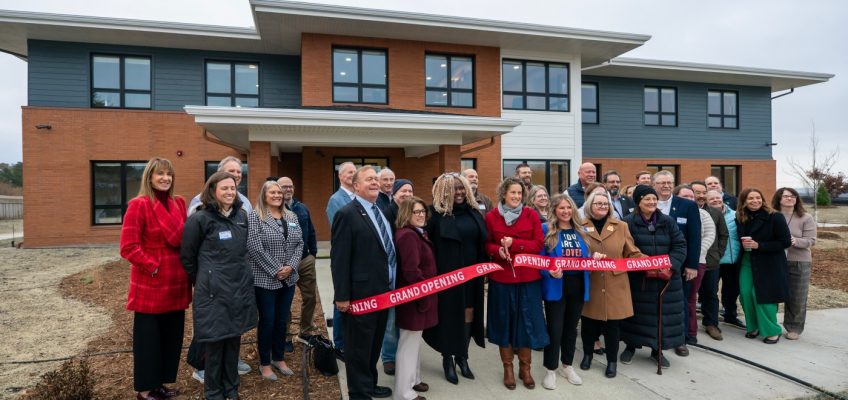Sarah Tripple walked through Washington County’s first homeless shelter on Wednesday morning, stopping often to point out some of her favorite features — and struggling to rank them against each other.
Washington County Community Services Division Manager Sarah Tripple shows off a fully accessible residential room. (Claudia Staut / Pioneer Press)
“This is a fully accessible room,” said Tripple, division manager of Washington County Community Services, walking into a spacious room with its own bathroom, a double bed, side table, desk, desk chair, dresser and lounge chair.
“The trend we’ve been seeing is that the folks coming into our program are trending older and have more physical disabilities, so when we designed this building, we wanted to make sure that we were as ADA compliant as possible,” she said.
The room — one of two in the Stillwater shelter that is fully accessible — features a wide doorway, grab bars in the bathroom and a “roll-in” shower, she said.
“The windows open, so they can get some air in here,” Tripple said. “And they have a thermostat that they can move a couple of degrees one way or the other.”
Down the hall of the $12 million Emergency Housing Services Building, located on 1.5 acres on the south end of the Washington County Government Center campus in Stillwater, is a lounge area and game room with a TV. A quieter lounge area and library — complete with books from local libraries — can be found on the second floor.
‘We’ve been negligent’
The shelter, which will open the second week of December, will provide short-term emergency housing to individuals over the age of 18. With 30 private rooms, each with their own bathroom, it will provide adults experiencing homelessness a place to stay while county officials help them find permanent housing and employment, Tripple said.
The average stay is expected to be around 90 days. The shelter will be staffed 24/7 and residents will have access to social-service support, transportation assistance, well-being support, legal help and help in gathering essential documents. There is a computer lab for job searches and workforce development, a commercial kitchen and shared dining area, storage space and parking. Each room can be locked; residents will have access to their room via a key card, Tripple said.
On any given night, an average of 166 people in Washington County experience homelessness, according to county officials. Historically, as many as 54 residents each year have had to seek shelter outside the county.
“I think we’ve been negligent as a county in providing this service,” said Commissioner Fran Miron, who represents the northern part of Washington County. “Ramsey and Hennepin counties have been doing most of this work for some time, and I know a lot of our people that need emergency housing have been going into those counties to secure that. Now we’ve stepped up to the plate, and we’re doing the work that’s necessary.”
Miron said the county’s population will be judged on how well the “most needy among us” are treated. “I’ve heard the gospel readings in church many, many times,” Miron said.
Commissioner Bethany Cox, who represents the Stillwater area, was one of the featured speakers at the shelter’s ribbon cutting on Wednesday morning. “Homelessness does not discriminate,” Cox told the audience. “It touches individuals and families across our county, often during the most vulnerable moments of their lives. This building stands as a testament to compassion backed by action. The idea for this facility grew out of the pandemic, and when we had to quickly adapt and use hotels to shelter our most vulnerable residents, we knew there was a better way. That experience taught us valuable lessons about flexibility, about dignity, and the importance of safe spaces.”
County officials have been using Asteria Inn & Suites in Stillwater, which is just a half-mile west of the site, to provide emergency housing. Most of the 11 people currently being housed at the hotel are 60 and above, said Jennifer Castillo, Washington County’s director of community services. The oldest person served by the program has been 80, she said.
St. Paul City Council bans cryptocurrency kiosks
‘Give to the Max Day’ aims to raise millions Thursday for nonprofits, schools
Two arrested after glue found in locks at St. Anthony Starbucks
St. Paul Parks Conservancy to absorb Great River Passage Conservancy
MNDOT to hold public meetings on Robert Street project
Older people can sometimes be harder to find housing for because of fixed incomes, mobility issues and difficulty finding employment, she said. “In Washington County, we’ve really been seeing the aging population, and we’re really starting to see that in the area of homelessness,” she said.
The new shelter is a “symbol of bringing humanity back to our community,” Castillo said.
“Instead of just requiring our neighbors to pick them up by their bootstraps or work harder, this is really embracing the fact that these are our neighbors, these are our community members,” she said. “They’re down on hard times, and we need to wrap ourselves around them and help them, and that betters the whole community.”
Eligibility — and pets
People tour the Great Hall inside the new Washington County Emergency Housing Service Building in Stillwater. (Claudia Staut / Pioneer Press)
Residents will be referred to the shelter by the Washington County Homeless Outreach Services Team and must meet eligibility criteria, including being over 18, passing a criminal background check, no active substance use and agreeing to actively participate in a housing plan. Anyone accepted to the program must be physically present and unsheltered in Washington County for at least a night before their stay commences; no walk-ups will be allowed.
Stepping Stone Emergency Housing will staff the building around the clock; the annual operating amount for the shelter is $1.4 million.
Residents may stay with partners or family members — there are seven double rooms in the shelter. They also will be allowed to keep their pets on site, a feature that Commissioner Karla Bigham says is key.
“People will not separate from their pets, even to get assistance,” Bigham said. “It’s very important that if we’re going to help all people experiencing homelessness, that we need to make sure that they are together with their pets, so that they get those services, and they’re not choosing one or the other.”
Said Castillo: “The last thing we want to do is erode any of the natural connections or supports that they have. We never wanted to have people make a choice of losing something by coming here. We wanted to make sure that this was an added value to their lives.”
The shelter features a “trauma-informed design” to reduce stress and nurture healing, said Emily Timm, an architect at LHB.
Woodbury man gets 30 years in federal prison for extorting minors after coercing sexually explicit videos
Afton native Jessie Diggins will retire following this season
Oak Park Heights ‘Taco Bell Mom’ Brenda Foley marks 30 years
MnDOT denies permit for Stillwater Lift Bridge tug-of-war before Vikings-Packers rivalry game
Stillwater: Community Thread’s Holiday Hope program again expects high demand
“We’ve incorporated a lot of natural light and natural materials like wood,” Timm said. “We used wood wainscoting in the lobby to generate a warm environment. We try to avoid triggering colors that might be too harsh, such as bright, bright reds and oranges that tend to be more triggering for some people, so we take that into consideration. We’ve used softer tones that are more neutral and calming and more natural.”
The two-story shelter includes laundry facilities on both levels. There also is a “hot box” room, or heat chamber, which can be heated to 140 degrees. Because clients could bring along bed bugs or lice from previous living arrangements, everything coming into the shelter — including outside donations — will be treated in the chamber upon arrival, Tripple said.
Heat treatments are effective because bed bugs and their eggs die when exposed to high temperatures, she said.




